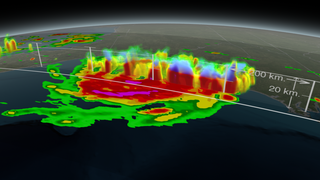Seeing Inside A Storm
Hurricane Arthur became the first storm of the 2014 Atlantic hurricane season. The storm formed on June 30 off the coast of Florida and was classified as a Category 2 hurricane when it made landfall over North Carolina on July 3. That morning, NASA’s Global Precipitation Measurement (GPM) Core Observatory satellite passed over the hurricane, detecting the drops of water that descended from its winding clouds. The satellite, which launched in February 2014, has two instruments that measure the location and intensity of water falling from inside a storm. Such observations help scientists distinguish the structure of features that power a hurricane, providing clues as to whether or not a storm will strengthen. Watch the video to see a 2D and 3D visualization of Arthur's precipitation as the hurricane approached shore.

A NASA satellite maps precipitation from a Category 2 hurricane.
In this video areas of the storm with high rates of precipitation are colored orange and red, while low rates appear yellow and green.

Satellite images show the storm taking shape off the coast of Florida on June 30 (left) and July 2 (right).

The eye of the hurricane can be seen in this 2D view of precipitation data taken by GPM.

Fine-scale precipitation structures of the hurricane are visible in this 3D image.
For More Information
See NASA.gov
Credits
Please give credit for this item to:
NASA's Goddard Space Flight Center
Satellite images courtesy of NASA/GSFC/MODIS Rapid Response Team
-
Animators
- Alex Kekesi (Global Science and Technology, Inc.)
- Greg Shirah (NASA/GSFC)
-
Producers
- Ryan Fitzgibbons (USRA)
- Rani Gran (NASA/GSFC)
-
Scientists
- Gail Skofronick Jackson (NASA/GSFC)
- George Huffman (NASA/GSFC)
- Dalia B Kirschbaum (NASA/GSFC)
-
Project support
- Laurence Schuler (ADNET Systems, Inc.)
- Ian Jones (ADNET Systems, Inc.)
- Chris Kidd (University of Maryland)
- John M. Kwiatkowski (George Mason University)
- William S. Olson (JCET/UMBC)
-
Writer
- Ellen T. Gray (ADNET Systems, Inc.)
Release date
This page was originally published on Tuesday, July 29, 2014.
This page was last updated on Wednesday, May 3, 2023 at 1:50 PM EDT.
